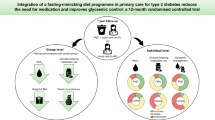Abstract
Postprandial blood glucose lowering effect of vitamin B6 (pyridoxine) was evaluated in healthy individuals with normal blood glucose levels. Blood glucose levels were measured every 30 min for 2 h after oral sugar administration with or without 50 mg of pyridoxine. Pyridoxine significantly lowered the postprandial blood glucose levels at 30 min (from 165.95 ± 17.19 to 138.36 ± 20.43, p < 0.01) and 60 min (from 131.40 ± 17.20 to 118.50 ± 15.95) after administration. In addition, the area under the concentration–time curve (AUCt) was reduced by about 8.3% (from 257.08 ± 22.38 to 235.71 ± 12.33, p < 0.05) and the maximum concentration of blood glucose (Cmax) was reduced by about 13.8% (from 165.95 ± 17.19 to 143.07 ± 11.34, p < 0.01) when compared with those of the control group. Our findings suggest that pyridoxine supplementation may be beneficial for controlling postprandial hyperglycemia.



Similar content being viewed by others
References
American Diabetes Association. Diagnosis and classification of diabetes mellitus. Diabetes Care. 35: S64–S71 (2012)
Bender DA. The Vitamins. pp. 132–187. In: Introduction to human nutrition. Gibney MJ, Lanham-New SA, Cassidy A, Vorster HH. (ed). John Wiley & Sons, Inc., Hoboken, NJ, USA (2009)
Boyle JP, Thompson TJ, Gregg EW, Barker LE, Williamson DF. Projection of the year 2050 burden of diabetes in the US adult population: dynamic modeling of incidence, mortality, and prediabetes prevalence. Popul. Health Metr. 8: 29 (2010)
Centers for Disease Control and Prevention. Diabetes Report Card 2014. Centers for Disease Control and Prevention, US Department of Health and Human Services, Atlanta, GA, USA (2015)
Hou CT, Wu YH, Huang PN, Cheng CH, Huang YC. Higher plasma pyridoxal 5′-phosphate is associated with better blood glucose responses in critically ill surgical patients with inadequate vitamin B-6 status. Clin. Nutr. 30: 478–483 (2011)
Hsu CC, Cheng CH, Hsu CL, Lee WJ, Huang SC, Huang YC. Role of vitamin B6 status on antioxidant defenses, glutathione, and related enzyme activities in mice with homocysteine-induced oxidative stress. Food Nutr. Res. 59: 25702 (2015)
Kannan K, Jain SK. Effect of vitamin B6 on oxygen radicals, mitochondrial membrane potential, and lipid peroxidation in H2O2-treated U937 monocytes. Free Radic. Biol. Med. 36: 423–428 (2004)
Kim HW, Kang YR, Lee JY, Chang HB, Lee KW, Apostolidis E, Kwon YI. The postprandial anti-hyperglycemic effect of pyridoxine and its derivatives using in vitro and in vivo animal models. Nutrients. 10: 285–296 (2018)
Morris MS, Picciano MF, Jacques PF, Selhub J. Plasma pyridoxal 5-phosphate in the US population: the National Health and Nutrition Examination Survey, 2003–20041–4. Am. J. Clin. Nutr. 87: 1446–1454 (2008)
Odum EP, Wakwe VC. Plasma concentrations of water soluble vitamins in metabolic syndrome subjects. Niger. J. Clin. Pract. 15: 442–447 (2012)
Roth-Maier DA, Kettler SI, Kirchgessner M. Availability of vitamin B6 from different food sources. Int. J. Food Sci. Nutr. 53: 171–179 (2002)
Van de Laar FA. Alpha-glucosidase inhibitors in the early treatment of type 2 diabetes. Vasc. Health Risk Manag. 4: 1189–1195 (2008)
Van de Laar FA, Lucassen PL, Akkermans RP, Van de Lisdonk EH, Rutten GE, Van Weel C. Alpha-glucosidase inhibitors for patients with type 2 diabetes: results from a Cochrane systematic review and meta-analysis. Diabetes Care. 28: 154–163 (2005)
Wei EK, Giovannucci E, Selhub J, Fuchs CS, Hankinson SE, Ma J. Plasma vitamin B6 and the risk of colorectal cancer and adenoma in women. J. Natl. Cancer Inst. 97: 684–692 (2005)
Acknowledgements
This research was financially supported by the Ministry of Trade, Industry, and Energy (MOTIE), Korea, under the “Regional Specialized Industry Development Program” supervised by the Korea Institute for Advancement of Technology (KIAT).
Author information
Authors and Affiliations
Corresponding author
Ethics declarations
Conflicts of interest
The authors declare no conflict of interest.
Additional information
Publisher's Note
Springer Nature remains neutral with regard to jurisdictional claims in published maps and institutional affiliations.
Rights and permissions
About this article
Cite this article
Kim, H.H., Kang, YR., Choi, HY. et al. Postprandial anti-hyperglycemic effect of vitamin B6 (pyridoxine) administration in healthy individuals. Food Sci Biotechnol 28, 907–911 (2019). https://doi.org/10.1007/s10068-018-0534-7
Received:
Revised:
Accepted:
Published:
Issue Date:
DOI: https://doi.org/10.1007/s10068-018-0534-7




